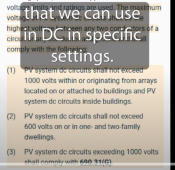So...
NEC requires any residential pv maximum voltage at 600V.
All continental Europe with 3 phase grid?Are there other countries allowing over 600V PV in residential setting?
What's the PV voltage limit for residential, there?All continental Europe with 3 phase grid?
So...
NEC requires any residential pv maximum voltage at 600V.

NEC really blocks any residential power over 600V class... but that isn't the *main* reason charge controllers often max out roughly there. There is (or at least was) a significant price delta between 600V, 1kV, and 1.5kV power electronics.NEC requires any residential pv maximum voltage at 600V.
The only thing I can see happening in a year or two is that the RSD, GFI, and Arc Fault data encourage a slight relaxing the PV voltage limits if installed in metallic conduit to the point where Vmp with temperature corrections is pushed up to 600V. I really can't imagine any residential electricians wanting to touch it though. Most are not sufficiently trained from a safety perspective to work with anything over 240VAC. (I don't view that as a fault... just as a job condition.)And I don't see that changing, any time soon.
Sunny Boys.Who would try to put 600v into an inverter?! Usually 12/24/48v will suffice…
Ok I know that’s not what you meant here, but it confuses the F out of me when I first joined this forum. Charge controllers accept PV input, not inverters. But many people seem to use the word inverter for any AIO. It’s confusing to beginners, and there seems to be a lot of beginners looking at AIO’s. They might buy an inverter and fry something when they try connecting their 250v PV input to their 48v inverter, “oh I need a charge controller?! What’s that?”




